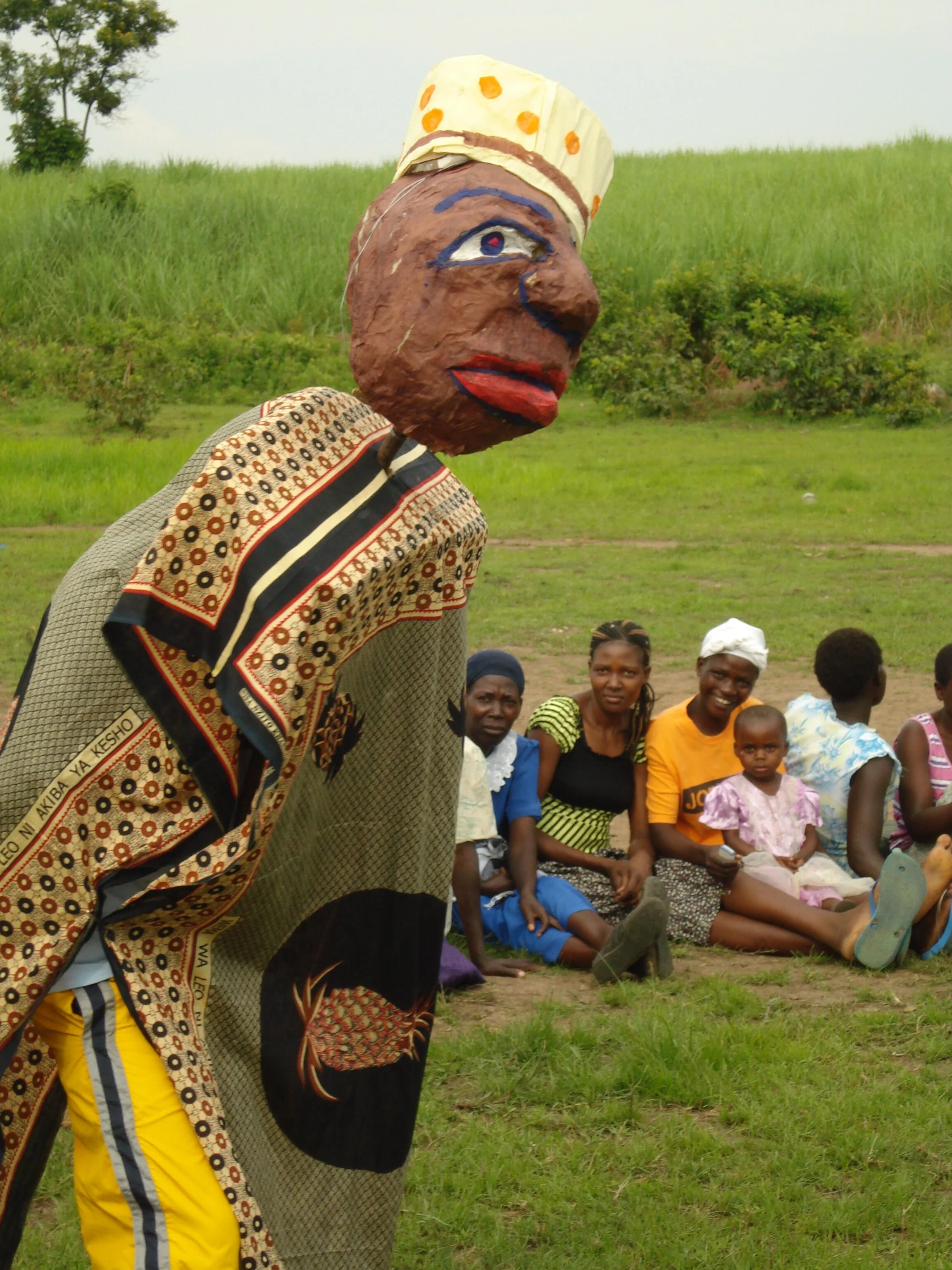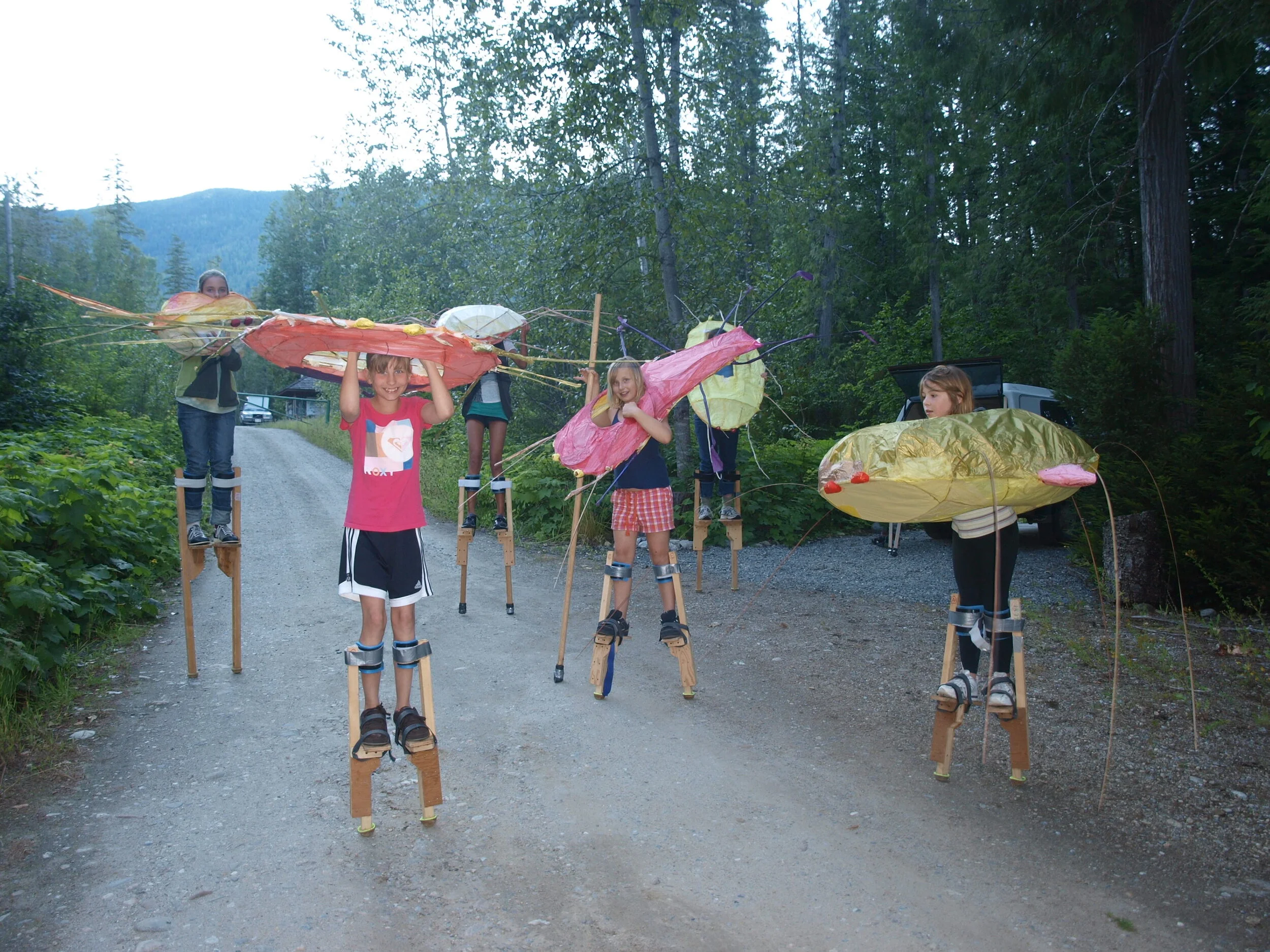


Sawllkwa / Water
Water takes many forms: rushing streams, still puddles, snowflakes, frost, fog, torrential rain.
All of the Water on Earth has been here for billions of years.
Everywhere in the world, the same water circulates.
It is shared by all beings, seen and unseen.
We explored these aspects of water in multiple ways with community members and with local and visiting artists, through dance/movement, ceramic vessel making fabric design, song and rhythm, storytelling, and spectacle.
The discoveries and materials all flowed between the components of the project.
Sawllkwa / Water Project Components:
Reflection - community art workshops for all ages in Enderby, Kingfisher and Splatsin, exploring the qualities of water through movement, fabric surface design, creating ceramic vessels, and music. (see more below)
In the Shade - weeklong arts camp in July 2010 about water through storytelling, fabric movement, and puppets.
The discoveries and materials made in these workshops all flowed into…
Sawllkwa Community Spectacle was presented on July 24th and 25th 2010, in the woods, on the beach, and in the water at the Kingfisher Interpretive Centre.
(see more below)
Pi en Ngima - Water is Life - collaborative community spectacle with local youth and visiting Runaway Moon artists, in Akonjo Kenya in December 2009
(see more below)
The World is Upside Down - touring puppet play about water and intercultural communication, in the Fall of 2010
Reflection Workshop series:
We were curious about how to “make” water, rather than making art “about” water, or “depicting” water. The distinction was often difficult to grasp, but this brought people into a rigorous creative process.
In the movement workshops, dancer Kristi Christian explored moving as a state of water, rather than describing water or being people-in-the water or using water.
Similarly, we challenged ourselves with making the fabrics about, but not a depiction, of water., Uschi Eder (Stitch resist) and Cathy Stubington (Fold-and-dye) we worked through this together: with Deb Humphries (Printmaking), lino prints of umbrellas, scenes, and emblems of water evolved to silkscreening the lines and shapes that water makes. Uschi Eder led Stitch-resist, and Akira Hanson experimented in different ways of using the fabric paints as water, encouraging us to “be” water as we painted.
Sue Saloka showed us how to make containers with clay slabs and coils, and Daniel Stark gave people the chance to try throwing on his wheel. They took the vessels to fire in their home studios. Potter Stephen Plante pointed out how pots are made from water, earth and fire. In his session we collected the clay locally, and built a fire to fire the pots.
People enjoyed, as always, singing and making rhythm with Murray MacDonald, and listening to and making the sounds of water, and composing a river song.
Workshops were free, and held in several public venues to broaden participation as much as possible. Additional tie-dye and printmaking workshops took place at A.L.Fortune Secondary School, Shihaya School, and many public events, where people of all ages made Water Flags.
At the source, we selected four artistic media through which to explore water through fall, winter and spring 2009-10.
In our “In the Shade” Weeklong Arts Camp, usually held in conjunction with a larger community project, a group of all ages learned about water through fabric movement (Kristi Christian), storytelling (Teresa Christian and Jimmy Ouma Okello), puppetmaking (Cathy Stubington), sound (Murray MacDonald), and stiltwalking (Varrick Grimes), and folded it all into a performance.
Click on images below to zoom in.
Sawllkwa
- Community Spectacle
A Community Spectacle “Sawllkwa” (which is the Secwepemc word for Water) was presented on July 24th and 25th, 2010. It took place in the woods, on the beach, and in the water at the Kingfisher Interpretive Centre, which is the home of a successful community-led salmon hatchery program a few miles upriver from Enderby. Our hour-long promenade style performance drew on Splatsin First Nation teaching stories, stories about the river from local residents, Celtic legends, and from the amazing qualities of water. A song “Kawuono Wan gi Pi” (“Today Water is here”), which was composed by two Akonjo girls for “Pi en Ngima”, also became part of Sawllkwa.
Sawllkwa / Water
Varrick Grimes (director),
Rosalind Williams (cultural consultant, co-writer),
Murray MacDonald (musical director), Cathy Stubington (artistic director, design coordinator), Kristi Christian (choreographer)
Dalynn Kearney (our inspirational Stage Manager).
Featuring visiting artists Jimmy Ouma (Kenya) and Zompopo Flores (El Salvador).
Created with community members from Enderby and Splatsin.
Click on program below to zoom in
Synopsis of Sawllkwa Community Spectacle
The audience arrived through the wooded drive to the Kingfisher Interpretive Centre, flanked with Water Flags. They were welcomed with three pre-show performances - an accordionist storyteller, a giant seahorse duo, and a “freak show”. From there the audience was ushered by water people down the hill to the giant gazebo, where they peered through mist to a musical/movement piece embodying the story, from Splatsin oral history, of the emanation of land from the water.
Then the audience was divided into six groups, each led (by an interesting host on stilts) along paths in the woods where they visited each of six short performances:
a song/dance of Coyote and Grizzly competing wish for day and night,
a storytelling about near-drowning experiences,
a puppet show of a Celtic story of a Selkie - a child half human and half seal, accompanied by harp
a handpuppet show in which clever Peetasah tricked the Chief into diving into the river,
a Beaver demonstrating how upstream/downstream activity affects the travels of two fish,
a miniature puppet play about how Sek’lep (Coyote) brought the Salmon to the Interior.
The audience reconnected and were surprised by a dance/rhythm piece using water as a percussion instrument, interrupted by a dance of giant water creatures (stiltwalkers). Then they were led through the woods past a dance of underwater puppet creatures and a sea-serpent. Then they filed one at a time through an opening onto the beach, where each person was given a ceramic vessel to carry with them down to the water.
Down they walked along the spiral pebble paths to the river, where dancers in the water poured water from the river into the vessels. Finally, the water was carried back carefully through the woods as night fell, and poured into a giant reflection pool in the centre of the gazebo during the musical finale.
PI EN NGIMA (Water is Life)
Water is necessary to all of us, and all of the water in the world is linked!
A partner community spectacle took place in Akonjo Kenya,
It was led by our project partner Jimmy Ouma Okello, and three visitors from Runaway Moon: Murray MacDonald, Varrick Grimes and Cathy Stubington. Performers were from “Dwe Maringo” youth and other youth from the village. Some of the Enderby Water Flags were brought to Akonjo and became part of Pi en Ngima.
This was part of a cultural exchange with Akonjo, where Shuswap residents had been supporting a partnership project with Akonjo Community Enhancement Society including Youth Leadership Water Awareness.
Artistic Process
Sawllkwa Community Spectacle:
All aspects of the performance were generated through community involvement. There was a call out for performers, and Director Varrick Grimes invited people to contribute stories about water, whether from imagination, memory, or tradition. Varrick has an overflowing imagination and all of the suggestions became performative, with style being matched with story. Cultural historian Rosalind Williams brought to the table traditional Splatsin/Secwepemc stories that she deemed necessary to be part of it.
The materials and “stuff” created in the workshops both informed and folded into the performance. There were many more opportunities to make stuff: The Water Fabrics were sewn into robes for the cast, which both individual and together became a stunning visual. The ceramic vessels became part of a ceremony. Puppets made at “In the Shade” were part of Sawllkwa, and some of the children who’d learned to walk on stilts became giant water creatures.
For three weeks we occupied a community hall, where both rehearsals and intense making took place. Every day was eventful in itself. As more people joined in, more robes were needed; fabric was tie-dyed, and hung outdoors where it could be seen flapping in the wind. Certain characters needed masks, so some people helped make them and fit them on the performers. Puppets that were made both in the hall and in groups in peoples’ homes.
Varrick and the core artists sought to make the shape and structure of the performance itself follow ways in which water flows and pools, joins and separates. In the grounds of the interpretive centre we found opportunities to move the audience from place to place, sometimes all at once, then trickling out into smaller groups, becoming a narrow river when going through the woods, peering through mist as they watched a re-enactment of the past.
On one special day leading up to the event, several of us gathered on the beach by the bend in the river at the Kingfisher Interpretive Centre, and arranged rocks and pebbles into spiral paths for the audience to follow down to the water.
Each song came from an interesting place. One was created collaboratively during Murray’s workshops. “Kawuono Wan gi Pi” (“Today Water is here”), came from Akonjo, where it had been made by two girls for “Pi en Ngima”. The full cast sang a song about weather in Secwepemctsin. A song was composed of words for water in many different languages, that Cathy had been collecting from people over several months. Musical compositions came from exploring the sounds that water makes. Rosalind wanted the songs to be a conversation “with” (rather than describing or praising) water; we learned the act of singing as a conversation with the world around us.
Sawllkwa (and other Runaway Moon performances) had elements of ritual. We did not describe it as such, but when each audience member carried a small amount of water through the woods and poured it into a common vessel, something very special and unspoken took place. Through this and other ceremonies we bring local people together to recognize our essential connection to the earth and its elements.

























